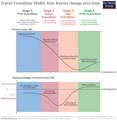Forest Transitions: the U-shaped curve of forest change
What’s surprising is how consistent the pattern of change is across so many countries; as we’ve seen they all seem to follow a ‘U-shaped curve’. They first lose lots of forest, but reach a turning point and begin to regain it again.
We can illustrate this through the so-called ‘Forest Transition Model’. This is shown in the chart. It breaks the change in forests into four stages, explained by two variables: the amount of forest cover a region has, and the annual change in cover (how quickly it is losing or gaining forest).
Stage 1 – The Pre-Transition phase is defined by having high levels of forest cover and no or only very slow losses over time. Countries may lose some forest each year, but this is at a very slow rate. Mather refers to an annual loss of less than 0.25% as a small loss.
Stage 2 – The Early Transition phase is when countries start to lose forests very rapidly. Forest cover falls quickly, and the annual loss of forest is high.
Stage 3 – The Late Transition phase is when deforestation rates start to slow down again. At this stage, countries are still losing forest each year but at a lower rate than before. At the end of this stage, countries are approaching the ‘transition point’.
Stage 4 – The Post-Transition phase is when countries have passed the ‘transition point’ and are now gaining forest again. At the beginning of this phase, the forest area is at its lowest point. But forest cover increases through reforestation. The annual change is now positive.


